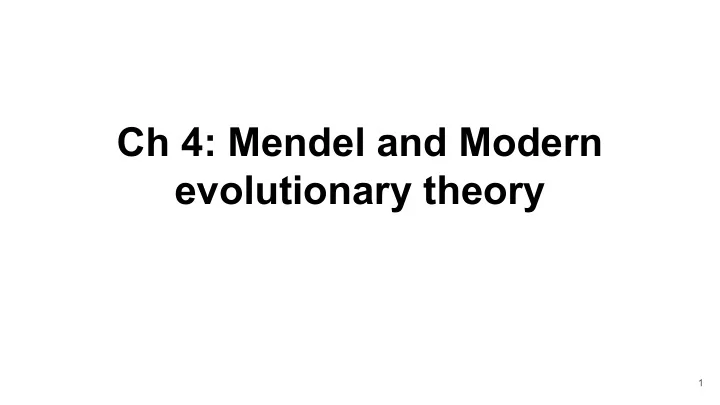

Ch 4: Mendel and Modern evolutionary theory 1
Mendelian genetics recap Principle of segregation: traits are controlled by discrete units which come in pairs and separate into sex cells. 2
Mendelian genetics recap Alleles: variations of a gene Allele pairs determines trait Genotype determines phenotype Tt determines tall pea plants 3
Mendelian genetics recap Dominant alleles mask the expression of recessive alleles. Homozygous: allele pairs (TT or tt or XX) Heterozygous: alleles pairs (Tt or XY) 4
Mendelian genetics recap Principle of segregation: traits are controlled by discrete units which come in pairs and separate into sex cells. Principle of independent assortment: traits are inherited separately 5
Mendelian genetics recap Mendelian traits -discrete traits -one gene determines one trait -rarely influenced by environment 6
Punnett square problems Hypothetically, B is the allele that causes brachydactyly. If a man with two normal alleles (bb) has average length fingers/toes has kids with a woman with brachydactyly (Bb). What proportion of their kids will have average length fingers/toes? 7
Variation and natural selection Polygenic traits -continuous -multiple genes determine one trait -relationship between genetics/environment heavily influential https://news.nationalgeographic.com/2018/02/ancient-face-chedd ar-man-reconstructed-dna-spd/ 8
Synthetic theory of evolution Two-stages of evolution involve variation and natural selection Stage 1: Factors produce and redistribute variation Stage 2: Natural selection acts on variation 9
Causes of evolution Mutations: any change in alleles -produces new alleles (only source of new genetic material) -only passed on if occurs in gametes E.g., sickle-cell anemia due to point mutation (changes in a single nucleotide base). 10
Causes of evolution Recombination: -chromosome pairs exchange DNA during meiosis -greater genetic diversity for natural selection to act on 11
Causes of evolution Genetic drift: changes in allele frequencies due to chance -large effect on smaller populations -larger populations match true math odds 12
Causes of evolution Founder effect: small subpopulation leaves to find new population E.g., polydactyly in Amish communities -founders/immediate descendants = carriers -homozygous recessive individuals emerged in gene pool 13
Causes of evolution Bottleneck: population shrinks and recovers -new population reflects genetic diversity of survivors E.g., Pingelap islanders today are mostly colorblind -Population descend from one of three typhoon survivors -carrier https://youtu.be/WCKB2ZgUzsI https://www.nationalgeographic.com/photography/proof/2018/0 1/pingelap-island-colorblindness-micronesia/ 14
Causes of evolution Gene flow (migration): exchange of genes between populations -when you move you pack up 23 pairs of chromosomes and take them with you E.g. Mutt versus purebred dogs https://www.nytimes.com/2014/08/17/magazine/should-you-fear -the-pizzly-bear.html?smid=pl-share 15
Causes of evolution Natural selection: -directional change relative to environmental context -acts on variation produced and redistributed by mutations, recombination, drift, and migration 16
Anthropology example Sickle-cell anemia: genetically inherited blood disease Mutated hemoglobin collapses red blood cells into sickles leading to anemia and death 17
Anthropology example Expect: selection against sickle-cell trait Instead: 30% some regional populations are carriers 18
Anthropology example Correlation between geographic locations with a malarial pressure and high frequencies of SCT 19
Anthropology example Geographic distribution: Mediterranean, Arabian peninsula, Southeast Asia, West Africa. 20
Anthropology example Correlation between geographic locations with a malarial pressure and high frequencies of SCT Malaria: deadly parasitic infection spread by mosquitoes Carriers for SCT have a higher survival rate for malarial infection 21
Recommend
More recommend